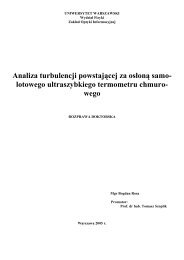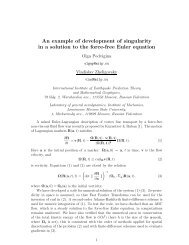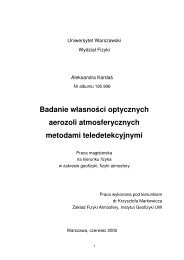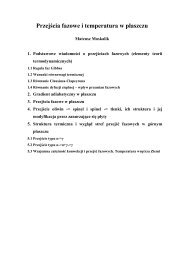Is B . n dS = 0,
Is B . n dS = 0,
Is B . n dS = 0,
You also want an ePaper? Increase the reach of your titles
YUMPU automatically turns print PDFs into web optimized ePapers that Google loves.
CHAPTER 2<br />
MAGNETOKINEMATIC PRELIMINARIES<br />
2.1. Structural properties of the B-field<br />
In §§ 2.1-2.4 we shall be concerned with basic instantaneous properties<br />
of magnetic field distributions B(x); the time dependence of B<br />
is for the moment irrelevant. The first, and perhaps the most basic,<br />
of these properties is that if S is any closed surface with unit outward<br />
normal n, then<br />
<strong>Is</strong> B . n <strong>dS</strong> = 0,<br />
i.e. magnetic poles do not exist in isolation. This global statement<br />
implies the existence of a single-valued vector potential A(x) satisfying<br />
B=VAA, V.A=O. (2.2)<br />
A is not uniquely defined by these equations since we may add to it<br />
the gradient of any harmonic function without affecting B; but, in<br />
problems involving an infinite domain, A is made unique by imposing<br />
the boundary condition<br />
A+O as(x(-+m. (2.3)<br />
At points where B is differentiable, (2.1) implies that<br />
V.B=O, (2.4)<br />
and across any surface of discontinuity S, of physical properties of<br />
the medium (or of other relevant fields such as the velocity field),<br />
(2.1) implies that<br />
[n . B] = (n . B)+ - (n . B)- = 0, (2.5)<br />
where the + and - refer to the two sides of S,, and n is now the unit<br />
normal on S, directed from the - to the + side. We shall always use<br />
the square bracket notation to denote such surface quantities.
The lines of force of the B-field (or ‘B-lines’) are determined as<br />
the integral curves of the differential equations<br />
A B-line may, exceptionally, close on itself. More generally it may<br />
cover a closed surface S in the sense that, if followed far enough, it<br />
passes arbitrarily near every point of S. It is also conceivable that a<br />
B-line may be space-filling in the sense that, if followed far enough,<br />
it passes arbitrarily near every point of a three-dimensional region<br />
V; there are no known examples of solenoidal B-fields, finite and<br />
differentiable everywhere, with this property, but it is nevertheless a<br />
possibility that no topological arguments have yet been able to<br />
eliminate, and indeed it seems quite likely that B-fields of any<br />
degree of complexity will in general be space-filling.<br />
Now let C be any (unknotted) closed curve spanned by an open<br />
orientable surface S with normal n. The flux @ of B across S is<br />
defined by<br />
(2.7)<br />
where the line integral is described in a right-handed sense relative<br />
to the normal on S. Afiux-tube is the aggregate of B-lines passing<br />
through a closed curve (usually of small or infinitesimal extent). By<br />
virtue of (2.1), @ is constant along a flux-tube.<br />
A measure of the degree of structural complexity of a B-field is<br />
provided by a set of integrals of the form<br />
I, = Jvm A. B d3x (m = 1,2,3, - a),<br />
(2.8)<br />
where V, is any volume with surface S,,, on which n . B = 0.<br />
Suppose, for example, that B is identically zero except in two<br />
flux-tubes occupying volumes V1 and V2 of infinitesimal crosssection<br />
following the closed curves C1 and C2 (fig. 2.l(a)) and let<br />
and
MAGNETOKINEMATIC PRELIMINARIES 15<br />
2<br />
(4 (6)<br />
Fig. 2.1 (a) The-two flux-tubes are linked in such a way as to give positive<br />
magnetic helicity. (b) A flux-tube in the form of a right-handed trefoil knot;<br />
insertion of equal and opposite flux-tube elements between the points A<br />
and B as indicated gives two tubes linked as in (a).<br />
configuration as drawn, evidently B d3x may be replaced by Ql dx<br />
on C1 and
16 MAGNETIC FIELD GENERATION IN FLUIDS<br />
More generally, if the Vm can be chosen so that Vco =u2=1 Vm,<br />
then<br />
(2.13)<br />
If a single flux-tube (with flux a) winds round itself before closing<br />
(i.e. if it is knotted) then the integral I, for the associated magnetic<br />
field will in general be non-zero. Fig. 2.l(b) shows the simplest<br />
non-trivial possibility: the curve C is a right-handed trefoil knot;<br />
insertion of the two self cancelling elements between the points A<br />
and B indicates that this is equivalent to the configuration of fig.<br />
2.l(a) with a1 =@2=Q) so that I=2Q2. Knotted tubes may<br />
always be decomposed in this way into two or more linked tubes.<br />
It may of course happen that A . B 0; it is well known that this is<br />
the necessary and sufficient condition for the existence of scalar<br />
functions q(x) and Q(x) such that<br />
A=(CIVcp, B=Vt,b~Vcp. (2.14)<br />
In this situation, the B-lines are the intersections of the surfaces<br />
cp = cst., Q = cst., and the A-lines are everywhere orthogonal to the<br />
surfaces cp = cst. It is clear from the above discussion that B-fields<br />
having linked or knotted B-lines cannot admit such a representation.<br />
The same limitation applies to the use of Clebsch variables<br />
9, +, x, defined (if they exist) by the equations<br />
A=+Vcp+Vx, B=V@AV~. (2.15)<br />
For example, if B is a field admitting such a representation, with cp, t,b<br />
and x single-valued differentiable functions of x, then<br />
and<br />
A. B = VX . (VQ ~Vcp),<br />
= lVm<br />
VX .(Vt,b A Vcp) d3x<br />
(2.16)
MAGNETOKINEMATIC PRELIMINARIES 17<br />
since n . B = 0 on Sm. Conversely, if Im # 0 (as will happen if the<br />
B-lines are knotted or linked), then (2.15) is not a possible global<br />
representation for A and B (although it may be useful in a purely<br />
local analysis).<br />
The characteristic local structure of a field for which A. B is<br />
non-zero may be illustrated with reference to the example (in<br />
Cartesian coordinates)<br />
B = (Bo, 0, 0),<br />
A= (Ao,-;B~Z,<br />
$Boy), (2.17)<br />
where A. and Bo are constants; note that possible Clebsch variables<br />
are<br />
(2.18)<br />
there is here no closed surface on which n . B = 0, and the problem<br />
noted above does not arise. Clearly A. B = AoBo, and the A-lines<br />
are the helices with parametric representation<br />
x = (2Ao/Bo)t, y = cos t, z = sin t. (2.19)<br />
These helices are right-handed or left-handed according as AoBo is<br />
positive or negative.<br />
The quantity A. (V A A) for any vector field A(x) is called the<br />
helicity density of the field A; its integral I, over V,, is then the<br />
helicity of A; the integrals I,,, over V, can be described as ‘partial’<br />
helicities. The helicity density is a pseudo-scalar quantity, being the<br />
scalar product of a polar vector and an axial vector; its sign<br />
therefore changes under change from a right-handed to a lefthanded<br />
frame of reference. A field A that is ‘reflexionally symmetric’<br />
(i.e. invariant under the change from a right-handed to a<br />
left-handed reference system represented by the reflexion x’ = -x)<br />
must therefore have zero helicity density. The converse is<br />
not true, since of course other pseudo-scalar quantities such as<br />
(V A A). V A (V A A) may be non-zero even if A. (V A A)= 0.<br />
2.2. Magnetic field representations<br />
In a spherical geometry, the most natural coordinates to use are<br />
spherical polar coordinates (r, 8, q) related to Cartesian coordinates
18 MAGNETIC FIELD GENERATION IN FLUIDS<br />
(x, Y, 2) by<br />
x = r sin 8 cos p, y = r sin 8 sin p, z = r cos 8. (2.20)<br />
Let us first recall some basic results concerning the use of this<br />
coordinate system.<br />
Let +(r, 8, cp) be any scalar function of position. Then<br />
where<br />
L~+<br />
The vector identity<br />
1 a a 1 a2<br />
a0 sin 8 ap<br />
= (- -sin e-+T 7).<br />
sin 8 a0<br />
(2.21)<br />
(2.22)<br />
(x A V )2~ r2V2+ - 2(x . V)+ -x . (x . V)V$ (2.23)<br />
leads to the identification<br />
L2$ = (X A v)2$. (2.24)<br />
L2 is the angular momentum operator of quantum mechanics. Its<br />
eigenvalues are-n(n + 1) (n = 0, 1,2, . . .), and the corresponding<br />
eigenfunctions are the surface harmonics<br />
n<br />
Sn(8, cp) = 2 A,"P,"(cos 8) e'"', (2.25)<br />
m =O<br />
where P:(cos 8) are associated Legendre polynomials and the A,"<br />
are arbitrary complex constants; i.e.<br />
L2Sn =iln(n + l)Sn. (2.26)<br />
Now let f(r, 8,p) be any smooth function having zero average<br />
over spheres r = cst., i.e.<br />
277 77<br />
47rr2(f) = I f(r, 8, p) sin 8 d8 dp = 0. (2.27)<br />
0 0<br />
We may expand f in surface harmonics<br />
the term with n = 0 being excluded by virtue of (2.27). The func-
MAGNETOKINEMATIC PRELIMINARIES 19<br />
tions Sn satisfy the orthogonality relation<br />
and so the coefficients fn (r) are given by<br />
(SnSnr) = 0, (n# n'), (2.29)<br />
If now<br />
then clearly the operator L2 may be inverted to give<br />
the result also satisfying ($) = 0.<br />
Note that any function of the form f = x. V A A, where A is an<br />
arbitrary smooth vector field, satisfies the condition (2.27); for<br />
I,,.) *<br />
A <strong>dS</strong> = J,s(r) 6,r)<br />
n . (V A A) <strong>dS</strong> = r V . (V A A) dV= 0,<br />
(2.33)<br />
where S(r) is the surface of the sphere of radius r and V(r) its<br />
interior.<br />
A toroidal magnetic field BT is any field of the form<br />
BT = V A (xT(x)) = -X AVT, (2.34)<br />
where T(x) is any scalar function of position. Note that addition of<br />
an arbitrary function of r to T has no effect on BT, so that without<br />
loss of generality we may suppose that (T) = 0. Note further that<br />
x . BT = 0, so that the lines of force of BT ('BT-lines') lie on the<br />
spherical surfaces r = cst.<br />
A poloidal magnetic field BP is any field of the form<br />
BP = VA V A (xP(x)) = -VA (X AVP), (2.35)<br />
where P(x) is any Scalar function of position which again may be<br />
assumed to satisfy (P) = 0. BP does in general have a non-zero radial<br />
component.<br />
It is clear from these definitions that the curl of a toroidal field is a<br />
poloidal field. Moreover the converse is also true; for<br />
V A V A V A (xP) = -V2V A (xP) = -V A (xV'P). (2.36)
20 MAGNETIC FIELD GENERATION IN FLUIDS<br />
The latter identity can be trivially verified in Cartesian coordinates.<br />
Now suppose that<br />
Then<br />
B = B, +B, = V A V A (xP) +V A (xT).<br />
(2.37)<br />
x . B = -(x A V)2P, x . (V A B) = -(x A V)2T, (2.38)<br />
so that P and T may be obtained in the form<br />
P= -L-2(~. B),<br />
T= -L-2~. (V A B). (2.39)<br />
Conversely, given any solenoidal field B, if we define P and T by<br />
(2.39), then (2.37) is satisfied, i.e. the decomposition of B into<br />
poloidal and toroidal ingredients is always possible.<br />
If we ‘uncurl’ (2.37), we obtain the vector potential of B in the<br />
form<br />
A = V A (xP) +xT+ VU, (2.40)<br />
where U is a scalar ‘funetion of integration’. Since V . A = 0, U and<br />
T are related by<br />
V2U = -V. (xT) (2.41)<br />
By virtue of this condition, xT + VU may itself be expressed as a<br />
poloidal field:<br />
xT+VU = V A V A (xS),<br />
The toroidal part of A is simply<br />
Axisymmetric fields<br />
S = -L-2(r2T+x. VU).<br />
(2.42)<br />
AT = V A (xP) = -X AVP. (2.43)<br />
A B-field is axisymmetric about a line Oz (the axis of symmetry) if it<br />
is invariant under rotations about Oz. In this situation, the defining<br />
scalars P and T of (2.37) are clearly independent of the azimuth<br />
angle cp, i.e. T = T(r, 0), P = P(r, 0). The*toroidal field BT = -x A VT<br />
then takes the form<br />
B~ = (o,o, B~), B~ = -aT/ae, (2.44)
MAGNETOKINEMATIC PRELIMINARIES 21<br />
and so the BT-lines are circles r = cst., 8 = cst. about Oz. Similarly,<br />
AT = (0, 0, A,), A, = -aP/ae, (2.45)<br />
and, correspondingly, in spherical polars,<br />
where<br />
(2.46)<br />
x = r sin 8, A, = -r sin 8 dP/a8. (2.47)<br />
The scalar x is the analogue of the Stokes stream function $(r, 8) for<br />
incompressible axisymmetric velocity fields. The Bp-lines are<br />
given by x = cst., and the differential<br />
27r dx = (B, dr -BJ d8)27rr sin 8 (2.48)<br />
represents the flux across the infinitesimal annulus obtained by<br />
rotating about Oz the line element joining (r, 0) and (r + dr, 8 +do).<br />
It is therefore appropriate to describe x as the flux-function of the<br />
field Bp.<br />
When the context allows no room for ambiguity, we shall drop the<br />
suffix cp from B, and A,, and express B in the simple form<br />
where i, is a unit vector in the cp-direction’.<br />
The two-dimensional analogue<br />
B = Bi, +V A (/lip), (2.49)<br />
Geometrical complications inherent in the spherical geometry frequently<br />
make it desirable to seek simpler representations. In particular,<br />
if we are concerned with processes in a spherical annulus<br />
rl < r < r2 with r2 - rl
1<br />
22 MAGNETIC FIELD GENERATION IN FLUIDS<br />
Fig. 2.2 Local Cartesian coordinate system in a spherical annulus geometry;<br />
Ox is directed south, Oy east, and Oz vertically upwards.<br />
and P and T are given by<br />
V;P = -4,. B, V;T= -i, . (V A B), (2.51)<br />
where Vi is the two-dimensional Laplacian<br />
V; = (i, A v )~ = a2/ax + d2/ay ’. (2.52)<br />
If the field B is independent of the coordinate y (the analogue of<br />
axisymmetry), then P = P(x, z), T= T(x, z). The ‘toroidal’ field<br />
becomes<br />
and the ‘poloidal’ field becomes<br />
BT = Bi,, B = -dT/dx, (2.53)<br />
Bp=V~(Aiy), A = -aP/ax. (2.54)<br />
The Bp-lines are now given by A(x, z) = cst., and A is the fluxfunction<br />
of the Bp-field.<br />
Quite apart from the spherical annulus context, two-dimensional<br />
fields are of independent interest, and consideration of idealised<br />
two-dimensional situations can often provide valuable insights. It is<br />
then in general perhaps more natural to regard Oz as the direction<br />
of invariance of B and to express B in the form<br />
B = V A (A(x, y)i,) + B(x, y)i,. (2.55)
MAGNETOKINEMATIC PRELIMINARIES 23<br />
2.3. Relations between electric current and magnetic field<br />
In a steady situation, the magnetic field B(x) is related to the electric<br />
current distribution J(x) by Ampere’s law; in integral form this is<br />
fc B.dx=po J.n<strong>dS</strong>, (2.56)<br />
where S is any open orientable surface spanning the closed curve C,<br />
and po is a constant associated with the system of units used2. If B is<br />
measured in Wb m-’ (1 Wb m-’ = 104 gauss) and J in A m-2, then<br />
I,<br />
po = 4~ x 10-7 Wb A-’ m-l. (2.57)<br />
It follows from (2.56) that in any region where B and J are<br />
differentiable,<br />
VAB=~J, V.J=O, (2.58)<br />
and the corresponding jump conditions across surfaces of discontinuity<br />
are<br />
[n AB] = p Js, [n . J] = 0, (2.59)<br />
where Js (A m-l) represents surface current distribution. Surface<br />
currents (like concentrated vortex sheets) can survive only if dissipative<br />
processes do not lead to diffusive spreading, i.e. only in a-<br />
perfect electrical conductor. In fluids or solids of finite conductivity,<br />
we may generally assume that Js = 0, and then (2.59) together with<br />
(2.5) implies that all components of B are continuous:<br />
[B] = 0. (2.60)<br />
In an unsteady situation, (2.56) is generally modified by the<br />
inclusion of Maxwell’s displacement current; it is well known<br />
however that this effect is negligible in treatment of phenomena<br />
whose time-scale is long compared with the time for electromagnetic<br />
waves to cross the region of interest. This condition is certainly<br />
satisfied in the terrestrial and solar contexts, and we shall therefore<br />
neglect displacement current throughout; this has the effect of<br />
filtering electromagnetic waves from the system of governing equa- 1<br />
/T<br />
I - ‘/<br />
.<br />
Permeability effects are totally unimportant in the topics to be considered and may<br />
be ignored from the outset.
24 MAGNETIC FIELD GENERATION IN FLUIDS<br />
tions. The resulting equations are entirely classical (i.e. nonrelativistic)<br />
and are sometimes described as the 'pre-Maxwell equations'.<br />
In terms of the vector potential A defined by (2.2), (2.58)<br />
becomes the (vector) Poisson's equation<br />
V2A = -poJ. (2.61)<br />
Across discontinuity surfaces, A is in general -continuous (since<br />
B=VnA is in general finite) and (2.60) implies further that the<br />
normal gradient of A must also be continuous; i.e. in general<br />
[A] = 0, [(n . V)A] = 0. (2.62)<br />
Multipole expansion of the magnetic field<br />
Suppose now that S is a closed surface, with interior V and exterior<br />
e, and suppose that J(x) is a current distribution entirely confined to<br />
excluding the possibility of surface current on S,<br />
V, i.e. J = 0 in Q;<br />
we must then also have n . J = 0 on S. From (2.58), B is irrotational<br />
in p, and so there exists a scalar potential q(x) such that, in<br />
B = -VT, V2q = 0. (2.63)<br />
j , Note that in general !P is not single-valued; it is, however, singlet<br />
' valued if 9 is simply-connected, and we shall assume this to be the<br />
i case. We may further suppose that !P+ 0 as 1x1+ W.<br />
\<br />
Relative to an origin 0 in V, the general solution of (2.63)<br />
' j 1<br />
vanishing at infinity may be expressed in the form<br />
CO<br />
-_ \)q(x) = c !P(~)(x), ~(~'(x)<br />
/ fl=l<br />
= -Pg! s(r-l),ij ... s ; (2.64)<br />
here is the multipole moment tensor of rank n, r = 1x1, and a<br />
suffix i after the comma indicates differentiation with respect to xi.<br />
The term with n = 0 is omitted by virtue of (2.1). The terms with<br />
n = 1,2 are the dipole and quadrupole terms respectively; in vector<br />
notation<br />
W)(x) = -p . V(r-'),<br />
and similarly for higher terms.<br />
q(2)(x) = +*': VV(P),<br />
(2.65)
MAGNETOKINEMATIC PRELIMINARIES 25<br />
The field B in<br />
clearly has the expansion<br />
00<br />
Wx) = C ~'"'(x), B?'(x) = Pt!s(T-l),ij ... sa, (2.66)<br />
n=l<br />
and, since V2(r-') = 0 in the expression for B'"' may be expressed<br />
in the form B'"' = V A A'"' where<br />
The first two terms of the expansion for the vector potential,<br />
corresponding to (2.65), thus have the form<br />
A(')(x) = -p(') A V(r-'),<br />
A(2)(x) = ---P'~' i\ VV(r-'). (2.68)<br />
The tensors p'"' may be determined as linear functionals of J(x) as<br />
follows. The solution of (2.61) vanishing at infinity is<br />
A(x) = lv (x - x'1-l J(x') d3x', (2.69)<br />
(and it may be readily verified using V . J = 0, n . J = 0 on S, that this<br />
satisfies V . A = 0). The function Ix - x'1-l has the Taylor expansion<br />
(2.70)<br />
Substitution in (2.69) leads immediately to A = 1 A'"'(x) where<br />
Comparison with (2.67) then gives the equivalent relations<br />
(2.71)<br />
In particular, for the terms n = 1,2 we have<br />
(2.73)
26 MAGNETIC FIELD GENERATION IN FLUIDS<br />
Axis y mmetric fields<br />
If J(x) is axisymmetric about the direction of the unit vector i, = e,<br />
then these results can be simplified. Choosing spherical polar<br />
coordinates (r, 8,q) based on the polar axis Oz, we have evidently<br />
dl) = CL(% p(') = $po 11 Jq(r, 8)r3 sin2 8 dr d8.<br />
(2.74)<br />
Likewise, must be axisymmetric about Oz ; and since pj:) = 0<br />
from (2.733), it must therefore take the form<br />
(2, = (2)<br />
prnj E.L (ernej -iarnj).<br />
(2.75)<br />
Putting m = 3, j = 3 in (2.73) and (2.75) then gives p(2) in the form<br />
(2.76)<br />
In this axisymmetric situation, the expansion (2.64) clearly has the<br />
form<br />
(2.77)<br />
2.4. Force-free fields<br />
We shall have frequent occasion to refer to magnetic fields for which<br />
B is everywhere parallel to J = pOIV A B and it will therefore be<br />
useful at this stage to gather together some properties of such<br />
fields3, which are described as 'force-free' (Lust & Schluter, 1954)<br />
since the associated Lorentz force J A B is of course identically zero.<br />
For any force-free field, there exists a scalar function of position<br />
K(x) such that<br />
VAB=KB, B.VK=O, (2.78)<br />
the latter following from V . B= 0. K is therefore constant on<br />
B-lines, and if B-lines cover surfaces then K must be constant on<br />
each such surface. A particularly simple situation is that in which K<br />
is constant everywhere; in this case, taking the curl of (2.78)<br />
In general, a vector field B(x), with the property that V A B is everywhere parallel to<br />
B, is known as a Beltrami field.
''<br />
MAGNETO KIN EM AT1 C P R E L I M I N A R I E S 27<br />
immediately leads to the Helmholtz equation<br />
(v2 + K~)B = 0. (2.79)<br />
Note however that this process cannot in general be reversed: a field<br />
B that satisfies (2.79) does not necessarily satisfy either of the<br />
equations V A B = f KB.<br />
The simplest example of a force-free field, with K = cst., is, in<br />
Cartesian coordinates,<br />
B = Bo(sin Kz, cos Kz, 0). (2.80)<br />
The property V A B = KB is trivially verified. The B-lines, as indicated<br />
in fig. 2.3(a), lie in the x-y plane and their direction rotates<br />
t<br />
(4 (b)<br />
Fig. 2.3 (a) Lines of force of the field (2.80) (with K > 0). 0 indicates a line<br />
in the positive y-direction (i.e. into the paper), and 0 indicates a line in the<br />
negative y-direction; the lines of force rotate in a left-handed sense with<br />
increasing z. Closing the lines of force by means of the dashed segments<br />
leads to linkages consistent with the positive helicity of the field. (b) Typical<br />
helical lines of force of the field (2.82); the linkages as illustrated are<br />
negative, and therefore correspond to a negative value of K in (2.82).<br />
with increasing z in a sense that is left-handed or right-handed<br />
according as K is positive or negative. The vector potential of B is<br />
simply A = K-lB, so that its helicity density is uniform:<br />
A. B = K-'B2 = K-'B$ (2.8 1)
28 MAGNETIC FIELD GENERATION IN FLUIDS<br />
If we imagine the lines of force closed by the dashed lines as<br />
indicated in the figure, then the resulting linkages are consistent<br />
with the discussion of 8 2.1.<br />
A second example (fig. 2.3(b)) of a force-free field, with K again<br />
constant, is, in cylindrical polars (s, cp, z),<br />
where J, is the Bessel function of order n. Here the B-lines are<br />
helices on the cylinders s = cst. Again A = K-lB, and<br />
A . B = K1B2 = K-'Bi[(J1(Ks))2 + (Jo(Ks))2], (2.83)<br />
and again any simple closing of lines of force would lead to linkages<br />
(which are negative, corresponding to a negative value of K, in Fig.<br />
2.3(6).<br />
In both these examples, the J-field extends to infinity. There are<br />
in fact no force-free fields, other than BE 0, for which J is confined<br />
(as in 8 2.3) to a finite volume V and B is everywhere differentiable<br />
and O(f3) at infinity4. To prove this, let Ki be the Maxwell stress<br />
tensor, given by<br />
with the properties<br />
Tj = pO1(B,B, -$B2Sij), (2.84)<br />
(J AB)~ = Tii, Ti = -(2pO)-lB2, (2.85)<br />
and suppose that J A B = 0. Then<br />
0 = xiKij d3x = <strong>Is</strong>m<br />
nixiTi <strong>dS</strong> -\ Ti d3x, (2.86)<br />
the volume integrals being over all space. Now since B = O(rV3) as<br />
r + 00, rj = O(r-6) and so the integral over S, vanishes. Hence the<br />
integral of B2 vanishes, and so B = 0. The proof fails if surfaces of<br />
discontinuity of B (and so of Kj) are allowed, since then further<br />
surface integrals which do not in general vanish must be included in<br />
(2.86).<br />
This condition means of course that the only source for B is the current distribution<br />
J, and there are no further 'sources at infinity'. The leading term of the expansion<br />
(2.66) is clearly O(F~). It is perhaps worth noting that the proof still goes through<br />
under the weaker condition B=o(~-~'~) corresponding to finiteness of the<br />
magnetic energy I Ki d3x.
MAGNETOKINEMATIC PRELIMINARIES 29<br />
Force -free fields in spherical geometry<br />
We can however construct solutions of (2.78) which are force-free<br />
in a finite region V and current-free in the exterior region and<br />
which do not vanish at infinity. This can be done explicitly (Chandrasekhar,<br />
1956) as follows, in the important case when V is the<br />
sphere r < R. First let<br />
(2.87)<br />
where KO is constant. We have seen in 8 2.2 that, under the poloidal<br />
and toroidal decomposition<br />
we have<br />
B = V A V A XP + V A xT, (2.88)<br />
VAB= -VA (XV~P)+VA v A (xT), (2.89)<br />
and so (2.78) is satisfied provided<br />
T=KP and (V2+K2)P=0. (2.90)<br />
Here K is discontinuous across r = R; but continuity of B ((2.60))<br />
requires that T, P and dP/dr be continuous across r = R, or equivalently<br />
P=O, [dP/dr]=O on r=R. (2.91)<br />
The simplest solution of (2.90), (2.91) is given in spherical polars<br />
(r, 07 d by<br />
where<br />
Ar-1/2J3/2(Kor) cos 0<br />
r - ~ ~ / cos r 0 ~ )<br />
(r < R)<br />
(r >R) ’<br />
(2.92)<br />
J3/2(KoR) = 0, and 3Bo = -A (d/dR)(R -1/2J3/2(K0R)),<br />
(2.93)<br />
the conditions (2.93) following from (2.91). The corresponding<br />
flux-function x(r, 0) is then given by (2.47); the B,-lines, given by<br />
x = cst., are sketched in fig. 2.4(a) for the case where KO < 0 and<br />
lKolR is the smallest zero of J3/2(~). For r>R, the B-lines are<br />
identical with the streamlines in irrotational flow past a sphere, and
30 MAGNETIC FIELD GENERATION IN FLUIDS<br />
(4 (b)<br />
Fig.2.4 (a) The B,-lines o( = cst.) of the force-free field given by (2.92),<br />
with K,R the smallest zero of J3&). (b) A typical B-line (a helix on a<br />
toroidal surface); the axis of symmetry is here perpendicular to the paper.<br />
B-Bo=Boi, as r+m. For r
MAGNETOKINEMATIC PRELIMINARIES , 31<br />
once and only once in this subset, since p /2~ passes through every<br />
rational number m/n once as it decreases continuously from infinity<br />
to zero; and yet the closed B-lines are exceptional in that they<br />
constitute a subset of measure zero of the set of all B-lines inside the<br />
sphere !<br />
More complicated force-free fields can be constructed either by<br />
choosing higher zeros of J3&COR) (in which case there is more than<br />
one magnetic axis) or by replacing (2.92) by more general solutions<br />
of (2.90). The above example is however quite sufficient as a sort of<br />
prototype for spatial structures with which we shall later be concerned.<br />
2.5. Lagrangian variables and magnetic field evolution<br />
We must now consider magnetic field evolution in a moving fluid<br />
conductor. Let us specify the motion in terms of the displacement<br />
field x(a, t), which represents the position at time t of the fluid<br />
particle that passes through the point a at a reference instant t = 0;<br />
in particular<br />
x(a, 0) = a,<br />
(d~,/da~),,~ = 6,. (2.95)<br />
Each particle is labelled by its initial position a. The mapping<br />
x=x(a, t) is clearly one-to-one for a real motion of a continuous<br />
fluid, and we can equally consider the inverse mapping a = a(x, t).<br />
The velocity of the particle a is<br />
uL(a, t) = (dx/at), = u(x, t); (2.96)<br />
uL (a, t) is the Lagrangian representation, and u(x, t) the more usual<br />
Eulerian representation. We shall use the superfix L in this way<br />
whenever fields are expressed as functions of (a, t), e.g.<br />
BL(a, t) = B(x(a, t), t) (2.97)<br />
represents the magnetic field referred to Lagrangian variables.<br />
Defining the usual Lagrangian (or material) derivative by<br />
-=($)a=($) D<br />
Dt<br />
X<br />
+u.v,<br />
(2.98)
32 MAGNETIC FIELD GENERATION IN FLUIDS<br />
it is clear that in particular<br />
--- DB=aB+~.VB=(~). dBL<br />
Dt at a<br />
(2.99)<br />
A material curve CL is one consisting entirely of fluid particles,<br />
and which is therefore convected and distorted with the fluid<br />
motion. If p is a parameter on the curve at time t = 0, so that<br />
a = a(p), then the parametric representation at time t is given by<br />
x = x(a(p), t); (2.100)<br />
the curve CL is closed if a(p) is a periodic function of p. A material<br />
surface SL may be defined similarly and described in terms of two<br />
parame ters.<br />
An infinitesimal material line element may be described by the<br />
differential<br />
dxi = Eij(a, t) dui, Eij(a, t) = dxi/aaj. (2.101)<br />
The symmetric and antisymmetric parts of Eij describe respectively<br />
the distortion and rotation of the fluid element initially at a. The<br />
material derivative of Eij is<br />
and so it follows that<br />
DEij/Dt = duf/daj, (2.102)<br />
D dx/Dt = dui duL/aaj = (dx . V)u, (2.103)<br />
a result that is equally clear from elementary geometrical considerations.<br />
Change of flux throigh a moving circuit<br />
Suppose now that<br />
@(t)=l B.<strong>dS</strong>=f A.dx, (2.104)<br />
SL<br />
CL<br />
where CL is a material curve spanned by SL. In order to calculate<br />
d@/dt we should use Lagrangian variables:<br />
@(t) = f Af(a, t)(dxi/daj)(daj/dp) dp. (2.105)<br />
CL
MAGNETOKINEMATIC PRELIMINARIES 33<br />
We can then differentiate under the integral keeping a(p) constant.<br />
This gives, using (2.103) and standard manipulation,<br />
x=#cL<br />
d@<br />
(E.<br />
dx+A. (dx. V)u)<br />
=fcL (!$-U<br />
A(VAA)+V(A. U)) . dx. (2.106)<br />
The term involving V(A . U) makes zero contribution to the integral<br />
since A. U is single-valued; and we have therefore<br />
d@<br />
Faraday's law of induction<br />
(Z-UAB) dA<br />
.dx.<br />
(2.107)<br />
In its most fundamental form, Faraday's law states that if @(t) is<br />
defined as above for any moving closed curve CL, then<br />
dQ,<br />
x -<br />
-$(E+u AB).<br />
dx, (2.108)<br />
where E(x, t) (Vm-') is the electric field relative to some fixed frame<br />
of reference. Comparison of (2.107) and (2.108) then shows that<br />
-E differs from dA/at by at most the gradient of a single-valued<br />
scalar 4 (x, t) :<br />
E + dA/dt = -V4. (2.109)<br />
The curl of this gives the familiar Maxwell equation<br />
dB/dt = -V A E. (2.110)<br />
The corresponding jump condition across discontinuity surfaces is,<br />
from (2. log),<br />
[n A (E + U A B)] = 0. (2.11 1)<br />
Galilean invariance of the pre -Maxwell equations<br />
The following simple property of the three equations<br />
V.B=O, VAB=~J, dB/dt=--VAE (2.112)<br />
is worth noting explicitly. Under the Galilean transformation<br />
x' =x-vt, t' = t, (2.113)
34 MAGNETIC FIELD GENERATION IN FLUIDS<br />
the equations transform to<br />
where<br />
V’ . B’ = 0, V’ A B’ = pJ’, aB’/at’ = -V’ A E’<br />
(2.114)<br />
B’=B, J’=J, E’=E+VAB. (2.115)<br />
(These are the non-relativistic limiting forms of the more general<br />
Lorentz field transformations of the full Maxwell equations.) It is<br />
important to note that B and J are invariant under Galilean transformation,<br />
but that E is not. For a fluid moving with velocity u(x, t),<br />
the field<br />
E’=E+uAB (2.116)<br />
is the electric field as measured by an observer moving with the<br />
fluid, and the right-hand side of (2.108) can therefore be regarded<br />
as (minus) the effective electromotive force in the moving circuit.<br />
Ohm’s law in a moving conductor<br />
We shall employ throughout the simplest form of Ohm’s law which<br />
provides the relation between electric current and electric field. In<br />
an element of fluid moving with velocity U, the relation between the<br />
fields J‘ and E’ in a frame of reference moving with the element is the<br />
same as if the element were at rest (on the assumption that acceleration<br />
of the element is insufficient to affect molecular transport<br />
processes), and we shall take this relation to be J’ = (TE’ where U is<br />
the electric conductivity of the fluid (measured in A V-’ m-’),<br />
Relative to the fixed reference frame, this relation becomes<br />
J=u(E+uAB). (2.117)<br />
It must be emphasised that, unlike the relations (2.112) which are<br />
fundamental, (2.1 17) is a phenomenological relationship with a<br />
limited range of validity. Its justification, and determination of the<br />
value of U in terms of the molecular structure of the fluid, are topics<br />
requiring statistical mechanics methods, and are outside the scope<br />
of this book.<br />
If we now combine (2.61), (2.109) and (2.117), we obtain<br />
immediately<br />
aA/dt =U A (V A A) - V$ +hV2A, (2.118)
MAGNETOKINEMATIC PRELIMINARIES 35<br />
where A = (pea)-' is the magnetic diffusivity of the fluid. Clearly,<br />
like any other diffusivity, A has dimensions length2 time-'; unless<br />
explicitly stated otherwise, we shall always assume that A is uniform<br />
and constant. The divergence of (2.118), using V . A = 0, gives<br />
v2+ = v . (U A B). (2.119)<br />
The curl of (2.118) gives the very well-known induction equation of<br />
magnetohydrodynamics<br />
a~/at = v A (U A B) +A V~B. (2.120)<br />
It is clear that if U is prescribed, then this equation determines<br />
(subject to appropriate boundary conditions) the evolution of<br />
B(x, t) if B(x, 0) is known. We shall consider in detail some of the<br />
properties of (2.120) in the following chapter.<br />
2.6. Kinematically possible velocity fields<br />
The velocity field u(x, t) is related to the density field in a moving<br />
fluid by the equation of conservation of mass<br />
ap/at + v . (pu) =G 0. (2.121)<br />
We have also the associated boundary condition<br />
u.n=O on S, j. (2.122)<br />
where S, is any stationary rigid boundary that may be present.<br />
These are both kinematic (as opposed to dynamic) constraints, and<br />
we describe the joint field (u(x, t), p (x, t)) as kinematically possible<br />
if (2.121) and (2.122) are satisfied. It is of course only a small subset<br />
of such fields which are also dynamically possible under, say, the<br />
Navier-Stokes equations with prescribed body forces; but many<br />
useful results aan be obtained without reference to the dynamical<br />
equations, and these results are generally valid for any kinematically<br />
possible flows.<br />
Equation (2.121) may be written in the equivalent Lagrangian<br />
form<br />
Dp/Dt= -pV . U. (2.123)<br />
We shall frequently be concerned with contexts where the fluid may<br />
be regarded as incompressible, i.e. for which Dp/Dt=O. In this
36 MAGNETIC FIELD GENERATION IN FLUIDS<br />
case, a kinematically possible flow u(x, t) is simply one which<br />
satisfies<br />
V.u=O, u.n=O onS,. (2.124)<br />
Conservation of mass may equivalently be represented by the<br />
Lagrangian equation for mass differentials,<br />
Now<br />
so that (2.125) becomes<br />
p (x, t) d3x = p (a,'O) d3a.<br />
For incompressible flow, this of course becomes simply<br />
(2.125)<br />
(2. 126)5<br />
(2.127)<br />
(2.128)<br />
2.7. Free decay modes<br />
In the absence of fluid motion, a current field J(x, t), confined to a<br />
finite region V, and its associated magnetic field B(x, t), decays<br />
under the action of magnetic ('ohmic') diffusion. Consideration of<br />
this straightforward effect is a useful preliminary to the topics that<br />
will be considered in later chapters. Suppose then that U = 0 in V, so<br />
that, from (2.120), B satisfies the diffusion equation<br />
Suppose further that the external region<br />
that<br />
This is equivalent to the statement<br />
d3x = J d3a,<br />
dB/dt = hV2B in V. (2.129)<br />
is non-conducting so<br />
poJ=V~B=O in Q. (2.130)<br />
J = d(x,, x2, x3)/d(u1, u2, u3).<br />
J is the Jacobian of the transformation x = x(a, t).
MAGNETOKINEMATIC PRELIMINARIES 37<br />
We have also the boundary conditions<br />
[B]=O onS, B=O(r-3)asr+C0, (2.131)<br />
where S is the surface of V.<br />
The natural decay modes for this problem are defined by<br />
B(x, t) = B'"'(x) exp pat, (2.132)<br />
where B '"'(x) satisfies<br />
(v' -PJA)B(") = o in V,<br />
v A B'"' = o in Q, (2.133)<br />
[B'"'] = 0 on S,<br />
B'"' = O(r-3) as r + CO.<br />
Equations (2.133) constitute an eigenvalue problem, the eigenvalues<br />
being pa and the corresponding eigenfunctions B'"'(x). These<br />
eigenfunctions form a complete set, from the general theory of<br />
elliptic partial differential equations, and an initial field B(x, 0)<br />
corresponding to an arbitrary initial current distribution J(x, 0) in V<br />
may be expanded as a sum of eigenfunctions:<br />
For t > 0, the field is then given by<br />
B(x, 0) = 1 a,B'"'(x). (2.134)<br />
a<br />
B(x, t) = 1 a" B'"'(x) exp pat. (2.135)<br />
a<br />
Standard manipulation of (2.133) shows that<br />
-pa =A jyg (V A B'"')2 d3x/l (B'"')' d3x, (2.136)<br />
v,,<br />
where V, = V U 9. Hence all the pa are real and negative, qnd they<br />
>-') YJJ / d J)" i<br />
may be ordered so that ,I L. *W<br />
- i, ~<br />
0 >pal spa* apa3 2 * - . (2.137)<br />
When V is the sphere r
38 MAGNETIC FIELD GENERATION IN FLUIDS<br />
with associated current distribution<br />
A(& J= -VA<br />
(XV~P)+V A v A (xT). (2.139)<br />
The equations (2.129)-(2.131) are then satisfied provided<br />
aP/dt = hV2P, aT/dt = hV2T, in r < R,<br />
V2P=0, T=O, inr>R, (2.140)<br />
[PI = [dP/dr] = [ T] = 0 on r = R.<br />
Toroidal decay modes<br />
The field T may always be expanded in surface harmonics,<br />
i<br />
where, from (2.140), T'"'(r, t) satisfies<br />
at<br />
P ' = O<br />
forr2R.<br />
for r < R,<br />
(2.142)<br />
Putting T'"'(r, t) =f("'(r) exp pat, we obtain a modified form of<br />
Bessel's equation for f'"'(r), with solution (regular at r = 0)<br />
fn'(r)ar-1'2Jn+:(k,r), k: = -p,/h. (2.143)<br />
The boundary condition f'"'(R) = 0 is then satisfied provided<br />
Jn+4 (kR) = 0. (2.144)<br />
Let x, (q = 1,2, . . .) denote the zeros of Jn+:(x) (see table 2.1);<br />
then the decay rates -p, of toroidal modes are given by<br />
-p, = hRP2x:, (n = 1,2,. . . ; q = 1,2, . . .), (2.145)<br />
where a is now a symbol for the pair (n, 4). The general solution for<br />
T has the form (in r < R)
MAGNETOKINEMATIC PRELIMINARIES 39<br />
1 i<br />
4<br />
I 1 2 3 4 5 6<br />
7~ 27~ 37~ 41r 57~ 67~<br />
4.493 7.725 10.904 14.007 17.221 20-371<br />
5.763 9.095 12-323 15.515 18.689 21.854<br />
6.988 10.417 13.698 16.924 20-122 23.304<br />
4 8.813 11.705 15.040 18-301 21.525 24.728<br />
Table 2.1. Zeros xnq of Jn+i (x), correct to 3 decimalplaces.<br />
Poloidal decay modes<br />
We may similarly expand P in the form<br />
~ ( r 6, , CP, t) = C ~'"'(r, t)sn (6, v). (2.147)<br />
Now, however, since V2P = 0 for r > R, we have<br />
P)(r, t) = c,(t)r-(n+l), (r >R). (2.148)<br />
Hence continuity of P(n) and dP'"'/dr on r = R require that<br />
or, eliminating c, (t),<br />
aP'/ar + (n + I)R-'P) = o on r = R.<br />
Putting P(,)(r, t) = g, (r) exp pat for r < R, we now obtain<br />
(2.150)<br />
gn(r) Kr-''2Jn+ A(kar), k:=-pa/A, (2.151)<br />
as for the toroidal modes, but now the condition (2.150) reduces to6<br />
Jn-4 (kJ?) = 0, (2.152)<br />
This reduction requires use of the recurrence relation<br />
XJL(X) + vJy(x) = XJ,-l(X).
40 MAGNETIC FIELD GENERATION IN FLUIDS<br />
which is to be contrasted with (2.144). The decay rates for the<br />
poloidal modes are therefore<br />
-2 2<br />
-pa =AR X(n-1)q (U = 1,2,. ..; 4 = 172,. . .),<br />
(2.153)<br />
and the general solution for P, analogous to (2.146), is<br />
where, by (2.149),<br />
Behaviour of the dipole moment<br />
The slowest decaying mode is the poloidal mode with n = 1, q = 1<br />
for which (2.153) gives pa = -hR-2x&. This is a mode with dipole<br />
structure for r > R ; if we choose the axis 8 = 0 to be in the direction<br />
of the dipole moment vector ~'"(t), then clearly the angular<br />
dependence in the associated contribution to the defining scalar P<br />
involves only the particular axisymmetric surface harmonic<br />
sl(e, ~~)KCOS e.<br />
It is interesting to enquire what happens in the case of a magnetic<br />
field which is initially totally confined to the conducting region r < R<br />
(i.e. B(x, 0) = 0 for r > R). The dipole moment of this field (as well as<br />
all the multipole moment tensors) are then evidently zero since the<br />
magnetic potential !P given by (2.64) must be zero to all orders for<br />
r >R. It is sufficient to consider the case in which the angular<br />
dependence of B(x, 0) is the same as that of a dipole; i.e. suppose<br />
that only the term with n = 1 is present in the above analysis for the<br />
poloidal field. The dipole moment is clearly related to the coefficient<br />
cl(t). In fact, for r > R, using V2P = 0, we have<br />
BP = V A V A XP -V2xP+VV. xP = -V!P, (2.156)
MAGNET 0 KIN EM AT1 C P R E L I M I N A R I E S 41<br />
where<br />
* = - P- (x . V)P = -P-r dP/dr, (2.157)<br />
and with P=~~(t)r-~cos 0 (from (2.148)), this gives *=<br />
cl(t)r-' cos 0 also. Hence in fact the dipole moment is<br />
p'l'(t) = cl(t)iz, (2.158)<br />
and its variation with time is given by (2.155) with n = 1. Under the<br />
assumed conditions we must have<br />
c1(0) =I B123/2(k0qR)R3/2 = 0. (2.159)<br />
4<br />
For t > 0, Icl(t)( will depart from zero, rising to a maximum value in<br />
a time of order R 'A -l, and will then again decay to zero in a time of<br />
this same order of magnitude, the term corresponding to q = 1<br />
ultimately dominating.<br />
It is important to note from this example that diffusion can<br />
result in a temporary increase in the dipole moment as well as<br />
leading to its ultimate decay if no regenerative agent is present. It is<br />
tempting to think that a linear superposition of exponentially<br />
decaying functions must inevitably decrease with time; consideration<br />
of the simple function e-' -e-2t will remove this temptation;<br />
the function cl(t) in the above example exhibits similar behaviour.<br />
This possibility of diffusive increase of the dipole moment is so<br />
important that it is desirable to give it an alternative, and perhaps<br />
more transparent, formulation. To this end, we must first obtain an<br />
alternative expression for p'l), which from (2.73a) is given by<br />
8~p'l) = 1 x A(V A B) d3x. (2.160)<br />
First we decompose B into its poloidal dipole ingredient7 B1 and the<br />
rest, B' say, i.e. B = B1 +B', where B1 = O(F~), B'= O(F~) as<br />
r + 00. Since V A B' = 0 for r > R, we can rewrite (2.160) in the form<br />
877-p (l) = XA (V A Bl)dV+ XA (V A B')dV, (2.161)<br />
7<br />
By 'dipole ingredient' we shall mean the ingredient having the same angular<br />
dependence as a dipole field.
42 MAGNETIC FIELD GENERATION IN FLUIDS<br />
where as usual V, is the whole space. The second integral can be<br />
manipulated by the divergence theorem giving<br />
x A (V A B') d V =<br />
(x A (n A B') + 2(n . B')x) <strong>dS</strong>,<br />
(2.162)<br />
and since B' = O(U-~) at infinity this integral vanishes as expected.<br />
Similarly the first integral may be transformed using the divergence<br />
theorem and we obtain<br />
87~p(')=<br />
<strong>Is</strong> x A (n *B1) <strong>dS</strong>+2 1" B1 dV, (2.163)<br />
where S is the surface r = R. Now n A B1 is continuous across r = R,<br />
and on r = R +, B1 = V(p(l). V)r-'; the surface integral in (2.163)<br />
may then be readily calculated and it is in fact equal to (8~/3)p(');<br />
hence (2.163) becomes<br />
The rate of change of p(') is therefore given by<br />
(2.164)<br />
Hence change in p(l) can be attributed directly to diffusion of B1<br />
across S due to the normal gradient (n . V)B1 on S.


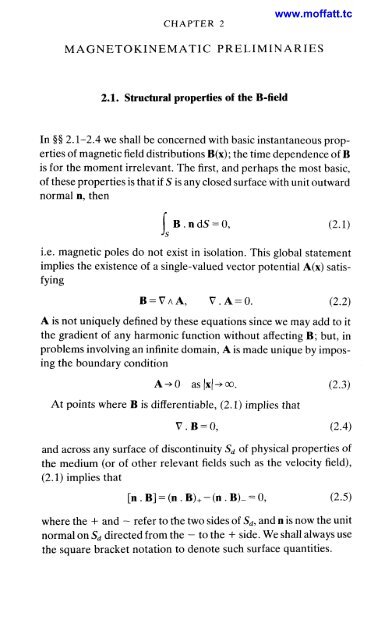
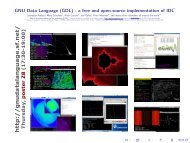

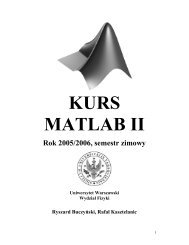
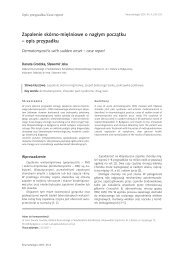
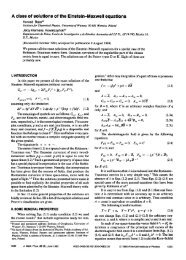
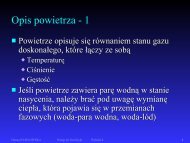
![slajdy [PDF, 0,6 MiB] - Instytut Geofizyki](https://img.yumpu.com/22546539/1/190x143/slajdy-pdf-06-mib-instytut-geofizyki.jpg?quality=85)
